There are lots of crossover SUVs available to choose from. Too many, arguably – in that so many are so much the same.
One that isn’t is the same-old same-old is the Mercedes GLE.
For one, it’s not based on a front-wheel-drive car, as is true of almost all non-luxury-brand crossover SUVs. For seconds. it’s available in both rear-drive and all-wheel-drive versions. Even a number of luxury-brand crossover SUVs – like the Lexus RX350 and Audi Q5 – are front-wheel-drive or all-wheel-drive.
The GLE is also the only vehicle in its class that is available with a four, a six or a V8.
And that makes it something very different.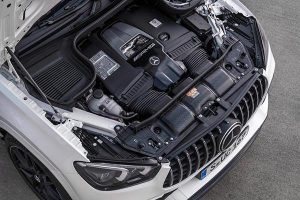
What It Is
The GLE looks like a mid-sized crossover SUV with seats for five or seven – depending on the configuration – which it is. But it’s also one of the few of its kind that’s built on a rear drive (rather than front-wheel-drive) layout, as most crossover SUVs are.
Prices start at $56,150 for the GLE350, which is rear-drive as it comes and comes standard with a 2.0 liter, turbocharged four cylinder engine. You can add all-wheel-drive (Mercedes calls its system “4Matic”) if you’d like more rainy-snowy day grip.
So equipped, the MSRP is $58,650.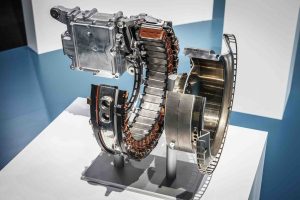
The GLE 450 comes standard with the 4Matic system – as well as a much more powerful turbocharged 3.0 liter inline six/mild hybrid powertrain.
It stickers for $63,950.
If the six in the GLE450 isn’t powerful enough, a more powerful version of this engine is available in the GLE 53, which also comes standard with a number of AMG (Mercedes’ high-performance equipment line) upgrades, such as a 20 inch wheel/tire package, high-capacity brakes, trim specific to this model and a premium Burmester audio system.
This one will set you back $74,150.
If you’d like to get set back in the seat just a bit more firmly, the GLE580 has you covered with a turbocharged V8 that gets you close to 500 horsepower. But if that’s not quite enough for you, there is the ultimate GLE. 
That one being the GLE 63 S. It comes standard with a 603 horsepower version of the V8 – which is enough power to move this crossover SUV from rest to 60 in 3.7 seconds.
It stickers for $116,50.
The GLE’s main rival is the BMW X5, which is also rear-drive/AWD and available with a V8 and third row seating. It’s more expensive to start – $60,600 – but it comes standard with a stronger (and larger) six cylinder engine.
There’s also the Porsche Cayenne – if you don’t need a third row, which this one doesn’t offer.
What’s New
The current GLE was all-new for 2020 so the current GLE is largely the same, except for some shuffling of standard and available features. For example, automatic high beams are now standard in all GLEs – while the scent dispenser system (Air Balance) is no longer available in the base GLE 350 trim. 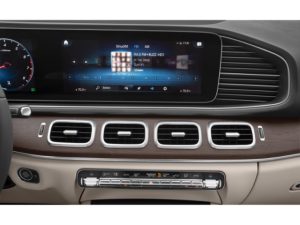
What’s Good
Four, six – or eight.
Five – or seven (seats).
Rear-drive or all-wheel-drive.
What’s Not So Good
Only the four is available with rear-drive.
The standard four isn’t much for what you spend.
The six – and eight – require you to spend a lot more.
The GLE comes standard with what is becoming standard in almost every new vehicle – a turbocharged 2.0 liter four cylinder engine.
This isn’t a coincidence.
Regulations in force in Europe – where Mercedes (as well as many other car companies) sells a lot of vehicles – have placed a de facto cap on the size of engines, everywhere – at least in cars produced in large numbers. Anything larger results in compliance problems – and costs. But anything smaller results in problems – with customers – who won’t buy under-engined/under-powered cars. The turbo 2.0 layout is big enough to make enough power when turbo-boosted – and small enough to not make too much gas (carbon dioxide) when it’s running.
So that’s why even a pretty big crossover SUV like the GLE comes standard with a comparatively little engine. It manages 255 horsepower – enough to get this pretty big crossover SUV to 60 in about 7 seconds.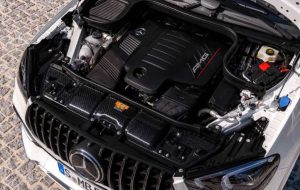
You can also get this version of the GLE in rear-drive, if you don’t want all-wheel-drive – and would rather not pay extra for it.
BMW offers the same “discount” – but the entry price point for the X5 (with rear-drive) is still about $2k higher than the GLE with its 4-Matic AWD system. But the BMW does come standard with a 3.0 liter turbo’d six that makes 335 horsepower and is much quicker to 60 (about 5.3 seconds for the rear-drive version).
BMW still offers a standard six in the X5 because it’s an older design (last updated in 2019). It is probable that when BMW updates it, the six will be optional – as it is in the newer-design Benz.
The Porsche Cayenne – another cross-shop – comes only with AWD and it costs a lot more to start, too ($69,000). The entry-level Cayenne does, however, come standard with more engine – a turbo’d 3.0 liter six that makes 335 horsepower.
Aber – as they say in Germany – one can upgrade to the GLE450 and get a 362 horsepower six for $58,650, which is still about $10k less than the cost of the entry-level Cayenne. This one also comes with a flywheel generator/starter system that boosts on-demand power for schnell acceleration – zero to 60 in about 5 seconds – while also cycling the six off as often as possible, so as to just about match the overall gas mileage of the GLE with the four. The latter rates 19 city 27 on the highway – with rear-wheel-drive. The GLE 450 – with AWD (and 107 more horsepower) rates 20 city, 25 highway.
Mercedes also offers a stronger (429 horsepower) version of the six in the GLE 53 but the Big Kahuna, so to speak, is the V8-powered version of the GLE. Which comes in two versions. So does the V8 version of the Porsche Cayenne, but the differences in horsepower – and price – are significant. The GLE 580 – which stickers for a relatively modest $80,900 – comes with a 483 horsepower, 4.0 liter V8. The V8-powered Cayenne GTS stickers for $109,000 and its V8 only manages 453 horsepower.
And that latter sum will almost buy you a GLE 63 S – with a 603 horsepower version of the 4.0 liter V8. This one massively outguns the $129,900 Porsche Cayenne Turbo (which has a 541 horsepower V8).
Porsche does offer an argument-ender, in the form of the Cayenne Turbo S E-Hybrid, which bundles the V8 with electric motor-assist to summon a titanic 670 horsepower (and 663 ft-lbs. of torque). But the price – $165,300 – is titanic to match. You could almost buy a GLE 63 S and a spare GLE 350 – maybe for commuting? – for the price of one Cayenne Turbo S E-Hybrid.
On the other hand, you could also buy a V8-powered (and 523 hp) BMW X5 for $82,800. And – for $107,095 – there’s the X5 M, which comes standard with a 600 hp 4.4 liter V8.
On the Road
Every crossover SUV drives nicely; the differences here are fine and mostly about fine-tuning.
Some have slightly quicker, more precise-feeling steering; others are a little firmer (or softer) in the seat. It is very difficult to make distinctions insofar as handling without really letting it all hang out – and that generally requires speeds and lateral movements not advisable (and definitely not legal) on public roads.
So what makes the GLE different?
Chiefly, what’s under the hood. And where what’s made there goes.
Even as regards the four, which isn’t a powerhouse by any means – and isn’t much different from the same-size fours in so many others. But it isn’t transversely-mounted and doesn’t drive the front wheels.
It is mounted front-to-back and send its power to the rear wheels, just as in sports cars. The feel of this form of power delivery is very different from that of its opposite – and not only in terms of acceleration from a standstill, though that feels better, too. In the curves, the rear-drive machine feels more weighted – and thus, balanced – because it is. The transverse-engined/front-drive car is literally more nose-heavy and for that reason not as balanced. It is also not possible – with FWD – to weight the rear wheels (and thus establish balance) by pushing down on the gas in the curves.
This is why FWD vehicles tend to understeer when pressed.
AWD corrects for this – but it also takes a bit away from the fun of this. There is less for the driver to do, because the AWD system is doing it for him. This is why the rear-drive GLE 350 is a more fun- to-drive crossover than its FWD/AWD rivals, such as the Audi Q5 and Lexus RX350.
The fun amps up considerably if you go for the GLE 450 – notwithstanding the standard AWD. Another 100-plus horsepower makes up for that.
The GLE’s inline six is also exceptionally smooth, as is true of this type of layout. Electric car-smooth, in fact – without the electric car tether. The GLE 450 can travel 562 highway (and 450 city) miles on a tankful, far surpassing the best-case advertised range of any EeeeeeeVeeeee. And you don’t have to wait 30-45 minutes at a “fast” charger to recharge, either – which isn’t much fun at all.
It’s more than just fun with the V8 – and not just because of the power. Because – notwithstanding a few subtle styling differences – there’s not much visual difference between a V8-powered GLE (even the GLE 63 S) and the handsome-looking but unthreatening-looking GLE 350. A V8-powered GLE can blend into the herd – until it’s time to lose the herd.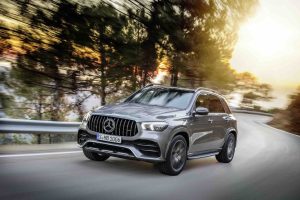
There is almost nothing that can match moves with a GLE 63 S – and the few that can are few and far between, on account of what they cost. It is immensely fun to drive a rig that can haul five or six kids around that can also spank a Mustang GT in stoplight drag and even keep pace with a Corvette.
At The Curb
The GLE and BMW X5 are closely aligned in terms of packaging – an important consideration when considering a crossover SUV. Both come standard with two rows of seats and the option to add a third row – upping the passenger capacity to seven. They also have roughly the same cargo-carrying capacity: 33.3 cubic feet behind the second row and 74.9 total for the Benz vs. 33.9 behind the second row and 72.3 for the BMW.
A more noticeable difference is that Benz has a lower ride height. It sits almost two inches closer to the road than the X5. This makes it more car-like to get into than the X5, though the X5 would probably do better in snow-driving than the Benz on account of having 8.7 inches of ground clearance vs. 7.1 for the GLE.
Both have digital gauge clusters but the GLE’s isn’t separated from the secondary LCD panel that controls (and displays) secondary functions such as the audio system. It’s a single large array that encompasses most of the upper dash. You don’t have to touch anything to change various settings; just ask the Mercedes to change the radio station, make a call or turn on the seat heaters. You can also control mute and volume via either of two extremely handy thumbwheel controls, one on the center console, the other on the steering wheel.
Both offer high-end audio systems, multi-color ambient mood lighting, big sunroofs and big wheels, too.
The biggest difference, though, is that the GLE has a plusher, more luxurious feel than the X5 – which leans more toward the sporty side of the aisle, as has been traditional for BMW vehicles for decades. This is by no means a fault.
It’s a difference.
Your choice depends upon your preference.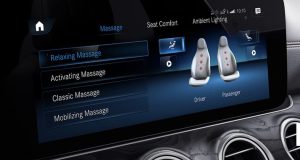
The Rest
One more difference is how much this Benz can pull vs. its main rival, the X5. The BMW pulls more with its standard six cylinder engine – 7,200 lbs. vs. just shy of 6,000 lbs. for the GLE 350 with its standard four cylinder engine. However, the Benz pulls more than the BMW when equipped with its optional six, to the tune of 7,700 lbs.
There isn’t much to carp about here except perhaps for the fact that even the GLE 450 does not come standard with massaging seats for the driver and front seat passenger. They are available, optionally, for another $1,100.
On the other hand, BMW charges extra for them, too – and charges more ($1,600 added to the tab).
The Bottom Line
It may not look all that different, but there are differences.
. . .
Got a question about cars, Libertarian politics – or anything else? Click on the “ask Eric” link and send ’em in! Or email me at EPeters952@yahoo.com if the @!** “ask Eric” button doesn’t work!
If you like what you’ve found here please consider supporting EPautos.
We depend on you to keep the wheels turning!
Our donate button is here.
If you prefer not to use PayPal, our mailing address is:
EPautos
721 Hummingbird Lane SE
Copper Hill, VA 24079
PS: Get an EPautos magnet or sticker or coaster in return for a $20 or more one-time donation or a $10 or more monthly recurring donation. (Please be sure to tell us you want a magnet or sticker or coaster – and also, provide an address, so we know where to mail the thing!)
My eBook about car buying (new and used) is also available for your favorite price – free! Click here. If that fails, email me at EPeters952@yahoo.com and I will send you a copy directly!













Good review. I’d almost choose rear wheel drive over a manual if that was the choice. Gives such a better driving feel. If I was in the new SUV market I guess it would be the RWD X5 with the standard dual turbo six.
Oh, are there any German cars with real names, not letters? They do love their alphanumeric designations. But something like Lyriq or Celestiq like Cadillac wants to do is no better, sounds like some kind of rash medicine 😉
Except for the grille lol. The German manufacturers definitely benchmark each other, so the GLE 63S, BMW X5M and Audi RS Q8 have similar horsepower, acceleration numbers and prices. And they copy each other’s bad ideas, like the screen overload. Still, we should enjoy these 600hp things while they still exist, who knows for how long.
Ha! That’s EXACTLY what I was saying to myself as I posted, Kitty! “The cars are all identical, only distinquishable by the different grills”.
And the model names! How does one even differentiate, since they’re just combinations of letters and numbers? The names are as bland and indistinquishable as the vehicles!
But. They. All. Look. The. Same!!!!!!
BMW does offer something comparable to the GLE 63 S. The BMW X5 M makes 600hp, and with the Competition package makes 617hp.